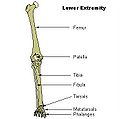
Hemimelia
Encyclopedia
Fibular hemimelia or longitudinal fibular deficiency is "the congenital absence of the fibula and it is the most common congenital absence of long bone of the extremities." It is the shortening of the fibula at birth, or the complete lack thereof. In humans, the disorder can be noted by ultrasound
in utero to prepare for amputation
after birth or complex bone
lengthening surgery
. The amputation usually takes place at 6-months with removal of portions of the legs to retro fit them for prosthetic use. The other treatments which include repeated corrective osteotomies and leg-lengthening surgery are costly and associated with residual deformity.

Ultrasound
Ultrasound is cyclic sound pressure with a frequency greater than the upper limit of human hearing. Ultrasound is thus not separated from "normal" sound based on differences in physical properties, only the fact that humans cannot hear it. Although this limit varies from person to person, it is...
in utero to prepare for amputation
Amputation
Amputation is the removal of a body extremity by trauma, prolonged constriction, or surgery. As a surgical measure, it is used to control pain or a disease process in the affected limb, such as malignancy or gangrene. In some cases, it is carried out on individuals as a preventative surgery for...
after birth or complex bone
Bone
Bones are rigid organs that constitute part of the endoskeleton of vertebrates. They support, and protect the various organs of the body, produce red and white blood cells and store minerals. Bone tissue is a type of dense connective tissue...
lengthening surgery
Surgery
Surgery is an ancient medical specialty that uses operative manual and instrumental techniques on a patient to investigate and/or treat a pathological condition such as disease or injury, or to help improve bodily function or appearance.An act of performing surgery may be called a surgical...
. The amputation usually takes place at 6-months with removal of portions of the legs to retro fit them for prosthetic use. The other treatments which include repeated corrective osteotomies and leg-lengthening surgery are costly and associated with residual deformity.
Common facts

- Partial or total absence of fibula is among most frequent limb anomalies.
- It is most common long bone deficiency and is the most common skeletal deformity in the leg.
- It most often is unilateral (present only on one side).
- Paraxial fibular hemimelia is the most common manifestation (only the postaxial portion of the limb is affected).
- It is commonly seen as complete terminal deficiency (lateral rays of the foot are affected as well).
- Hemimelia can also be intercalary in which case the foot remain unaffected.
- Although the missing bone is easily identified, this condition is not simply a missing bone.
- Males are affected twice as often as females in most series
See also
- Congenital abnormalityCongenital abnormalityA congenital anomaly is a condition which is present at the time of birth which varies from the standard presentation....
- List of congenital disorders
- ICD-10 Chapter Q: Congenital malformations, deformations and chromosomal abnormalities
- List of ICD-9 codes 740-759: Congenital anomalies
- Mitochondrial diseaseMitochondrial diseaseMitochondrial diseases are a group of disorders caused by dysfunctional mitochondria, the organelles that are the "powerhouses" of the cell. Mitochondria are found in every cell of the human body except red blood cells...
External links
- Journal of Joint Bone Surgery 1997 Jan;79(1):58-65.
- North American Reporting Center for Amphibian Malformations (NARCAM) Jul. 2011
- Minnesota's Malformed Frogs Jul. 2011
- Studies offer new insights into causes of deformed frogs Jul. 2011
- Deformed Frogs Raise Concerns Jul. 2011
- Deformed Frog Pictures Jul. 2011

